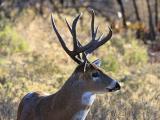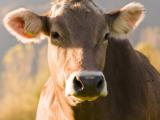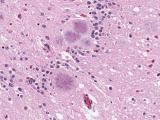May 11, 2005 (CIDRAP News) – The Pacific Northwest could have a higher risk of bovine spongiform encephalopathy (BSE) than the rest of the country because of past cattle imports from western Canada, where all four BSE cases in North America originated, the US Department of Agriculture (USDA) reported recently.
That assessment is one of the findings in a USDA report on the causes and implications of the four BSE (mad cow disease) cases and on Canada's epidemiologic investigation of them. The 27-page report was released Apr 29.
The report says that 29 cattle from the "birth cohorts" of the four BSE-infected cattle were shipped to the United States, and a total of about 18,000 Alberta cattle were sent to the United States in 1997 and 1998, the period when the four cattle were calves and probably contracted BSE by eating contaminated feed.
"Some of the data suggest that the Northwest region of the United States could be considered within a broadly defined movement area that could be at higher risk of exposure to BSE," the report states.
"While this region has historically imported a substantial number of cattle from western Canada, and a small portion of high-risk meat and bone meal was shipped to the area, the U.S. feed ban and other mitigations have effectively minimized the risk of transmission or amplification of the BSE agent."
North America's first BSE case in a native-born animal was identified in an Alberta cow in May 2003. The following December, the first American BSE case was found in a cow that had been imported into Washington state from Alberta. Two more cases were found in Alberta in January 2005.
The first Canadian BSE case prompted the United States to ban imports of all Canadian cattle and beef products. The border was later reopened to meat from younger cattle, but live cattle and meat from older cattle are still banned.
Shortly after the last two BSE cases surfaced, the USDA sent two technical teams to study the epidemiology of all four cases as well as Canada's ban on feeding ruminant animal protein to ruminants (cud-chewing animals such as cattle, sheep, goats, and deer).
In a USDA news release about the report, John Clifford, deputy administrator of the Animal and Plant Health Inspection Service, said, "Our technical team has completed its review and found that Canada's epidemiological efforts were not only appropriate but exceeded levels recommended by an international team of BSE experts. Canada's animal identification program allowed for a successful, comprehensive epidemiological investigation."
Because cattle contract BSE by eating feed containing protein from infected animals, both the United States and Canada banned the use of ruminant protein in feed for ruminants in 1997. The report says the four infected cows were all born between Oct 5, 1996, and Mar 21, 1997—either before or shortly after the feed ban took effect. The team concluded that all four cows contracted BSE by eating contaminated feed early in their lives.
Although the investigators didn't find a single source of potentially contaminated feed connecting all four cases, they did find strong evidence that three of the cows ate feed containing meat-and-bone meal (MBM) that one Alberta rendering plant shipped to local feed mills on Feb 28, 1997. The MBM would have been produced before the feed ban took effect.
"This MBM source similarity is extremely difficult to dismiss or ignore," the report says.
The fourth cow was not clearly connected to MBM from the same renderer, but a link couldn't be ruled out, the report says. All four cases occurred within a 280-mile-wide area of north-central Alberta. The one previous BSE case in North America—discovered in 1993 in a cow imported from the United Kingdom, where BSE was widespread—was in the same area.
In tracing the birth cohorts of the four infected cows, investigators identified a total of 853 cattle that came from the same herds of origin and were born within a year before or after an infected cow. Most of those had already been slaughtered or were euthanized. Of 29 cattle that were believed to have been shipped to the United States, 18 were found and were either euthanized or confirmed to have been slaughtered, USDA says.
About 18,000 cattle were shipped into the United States from "the Alberta region" in 1997 and 1998. These cattle "could represent another group of higher risk animals," in the view of the Canadian Food Inspection Agency (CFIA), the report states. However, an age-distribution model for US cattle suggests that fewer than 3% (540) of them remain in US herds now.
Canadian investigators also determined that the Alberta renderer that linked three of the BSE cases shipped two loads of MBM to the United States in February 1997. US investigators traced this material further and found that none had been made into cattle feed; most of it was exported to Asia, and the rest was used in poultry feed.
The view that the northwestern United States may have an increased risk is based on the CFIA's analysis of the flow of cattle and feed materials within Canada and from Canada to the United States before the BSE cases, the report explains.
The report also says that BSE probably was introduced into Canada by cattle imported from the United Kingdom early in the British epidemic, between 1986 and 1988.

















